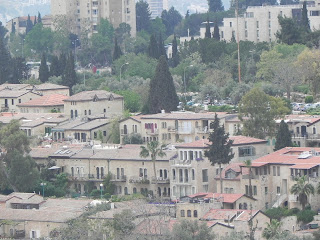Entering the Old City of Jerusalem is a sensation of converging sights, sounds, aromas and smells. Each turn on the narrow cobblestone alleyways, every ancient arch, each hidden courtyard instantly reflects a place and a mix (if not clash) of cultures and customs unfamiliar and interesting.
On our first day we entered Herod's Gate on the eastern side of the Old City, and focused on experiencing the largest quarter which is inhabited by the Muslims. Our guide, Nabile,
is a Christian Arab from a long line of Jerusalem Arabs who follow the Christian faith. We passed many mosques and minarets, making our way through the Muslim bazaar filled with goods ranging from clothing, shoes and jewelry, to farm fresh produce, sweets and meats.
is a Christian Arab from a long line of Jerusalem Arabs who follow the Christian faith. We passed many mosques and minarets, making our way through the Muslim bazaar filled with goods ranging from clothing, shoes and jewelry, to farm fresh produce, sweets and meats.
We entered the second largest quarter, inhabited by the Jewish, and we made our way through a complex of remodeled and modernized narrow pathways. This quarter is at once the oldest quarter and the newest neighborhood of the Old City. We entered the area of the First Jewish Temple Mount, which is currently the large, stone, building platform upon which stands the golden-covered Dome of the Rock Mosque.
We saw many groups of men praying and reading the Koran.
We saw the fountains used for the ritual of washing, which is required before a worshiper enters the Mosque.
Next we visited the Western Wall which is the holiest site in modern-day Jewry.
The wall is a section of the original Second Temple which was built around 538BC. Today, men and women enter separate sections of the wall, and make their petitions to God.
Every crack and crevice in the wall is stuffed with notes to God.
Quieted sniffles can be heard here. The area seems filled with a million expectations and sorrows.
Joan spent time at the wall, asking for a blessing; first for every family member, and then for each friend. Lastly, she asked for a blessing on all of us living on the planet.
We saw many groups of men praying and reading the Koran.
The wall is a section of the original Second Temple which was built around 538BC. Today, men and women enter separate sections of the wall, and make their petitions to God.
Every crack and crevice in the wall is stuffed with notes to God.
Quieted sniffles can be heard here. The area seems filled with a million expectations and sorrows.
Joan spent time at the wall, asking for a blessing; first for every family member, and then for each friend. Lastly, she asked for a blessing on all of us living on the planet.
The following day we entered Damascus Gate and followed narrow streets into the Christian, or Coptic Quarter. We made our way down the Via Dolorosa,
the path that is said to be the one Jesus walked while carrying the cross to his crucifixion. The "way of the cross" ends at the Church of the Holy Sepulcher
which is the shared property of the Egyptian Copts, the Armenian Christians, the Roman Catholics and the Greek Orthodox. The division of this massive church is unequal and uncomfortable, we are told. The church houses the Stone of Unction (place where the body of Jesus was to have been washed before burial),
Golgotha which was the " place of the scull"
or Calvary where Jesus was said to have been crucified, and the actual hole where the cross was set upright. The church also houses the tomb, although we were shown yet another tomb site nearby, wherein it is said that Jesus's body was laid.
Next, we entered the western Jaffa Gate and walked through the Jewish Quarter.
We spent several hours at the Citadel, which houses the Tower of David and the fortress which was built by King Herod over 2,000 years ago.
Today the complex houses a museum which provides an organized and historical perspective on this complex city. We learned that the city ( parts of, or the entirety) has been built, destroyed, and rebuilt some 7 times throughout it's embattled history. From the upper walls of the Citadel we had a panoramic view of the current Old City, the Mount of Olives, the Hebrew University, and the modern Jewish neighborhoods in western Jerusalem.
Next, we made our way through the smallest quarter, that of the Armenians, and entered the Room of the Last Supper.
After this, we walked around the region of Mt. Zion.
After this, we walked around the region of Mt. Zion.
After 2 days of walking in the Old City we were ready for a trip to the Dead Sea. But first back to the our lodging, The American Colony Hotel, dinner and a good night's sleep.































No comments:
Post a Comment